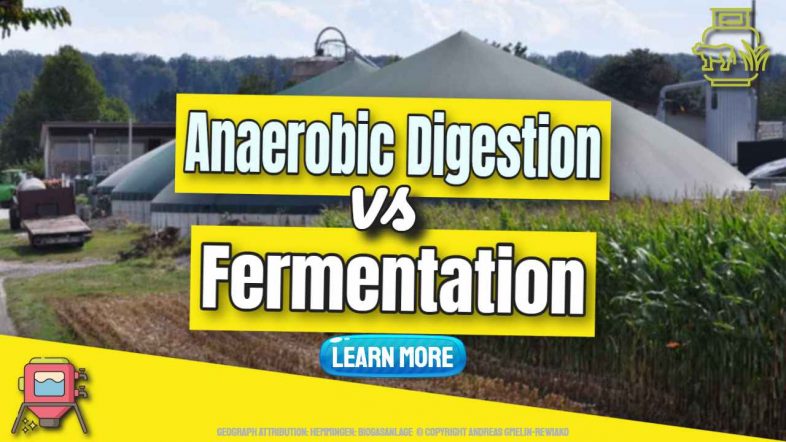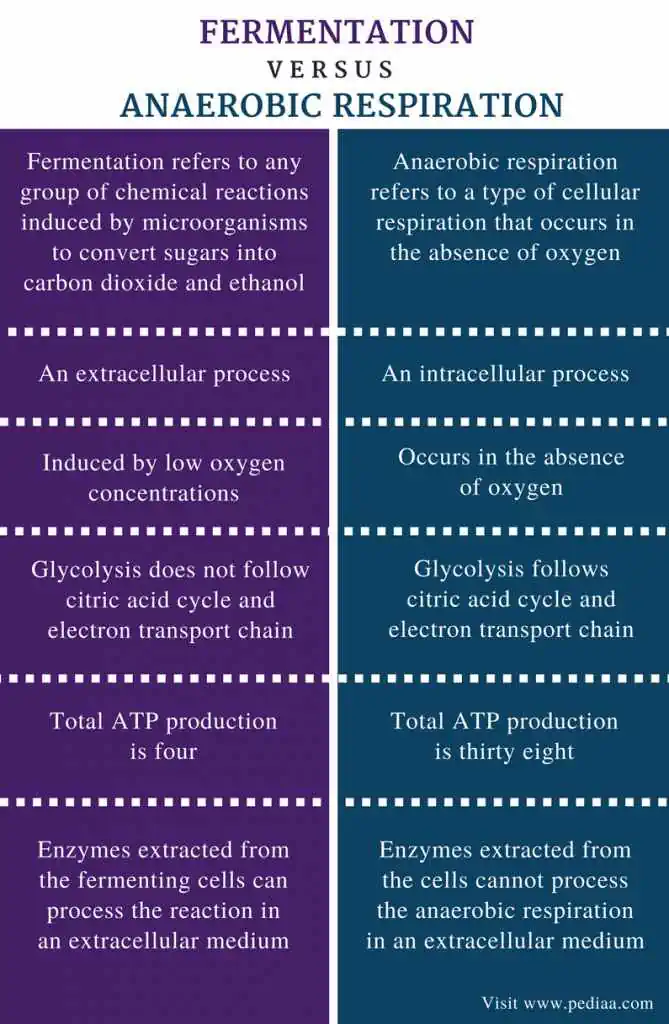In this case, before comparing the two ostensibly different processes Anaerobic Digestion vs Fermentation, the question arises whether they are not the same process that has simply been approached from different directions by separate scientific disciplines?
This could explain the use of two terms where one would suffice but would we be correct to say that?
No. The two processes are different! Read on to find out why!
The definition of anaerobic digestion according to Wikipedia is:
“Anaerobic digestion is a sequence of processes by which microorganisms break down biodegradable material in the absence of oxygen [naturally or in an anaerobic digester]. The process is used for industrial or domestic purposes to manage waste or to produce fuels. Much of the fermentation used industrially to produce food and drink products, as well as home fermentation, uses anaerobic digestion.
Anaerobic digestion occurs naturally in some soils and in lake and oceanic basin sediments, where it is usually referred to as “anaerobic activity”. This is the source of marsh gas methane as discovered by Alessandro Volta in 1776″: Wikipedia (AD page)
and the definition of fermentation from the same source is:
“Fermentation is a metabolic process that produces chemical changes in organic substrates through the action of enzymes. In biochemistry, it is narrowly defined as the extraction of energy from carbohydrates in the absence of oxygen. In food production, it may more broadly refer to any process in which the activity of microorganisms brings about a desirable change to a foodstuff or beverage. The science of fermentation is known as zymology.
In microorganisms, fermentation is the primary means of producing adenosine triphosphate (ATP) by the degradation of organic nutrients anaerobically. Humans have used fermentation to produce foodstuffs and beverages since the Neolithic age.
For example, fermentation is used for preservation in a process that produces lactic acid found in such sour foods as pickled cucumbers, kombucha, kimchi, and yogurt, as well as for producing alcoholic beverages such as wine and beer.
Industrial fermentation is the process of using microbes for the large-scale production of chemicals, biofuels, enzymes, proteins and pharmaceuticals. Fermentation also occurs within the gastrointestinal tracts of all animals, including humans.”
Via Wikipedia's Fermentation Page
We can hear our readers saying that this all sounds very technical and complicated. Most are only interested in the process that happens in the absence of oxygen in a sealed, oxygen-free tank called an anaerobic digester. So:
Is fermentation the same thing as anaerobic respiration?
The quick answer is no! The primary distinction between fermentation and anaerobic respiration is that fermentation and anaerobic respiration (in anaerobic digestion) are two different types of cellular respiration mechanisms.
They are used to generate ATP, which is required for cell function. In the absence of oxygen, both fermentation and anaerobic respiration occur. Hexose sugars are used as the substrate. Hexose sugars are first glycolyzed. The primary distinction between fermentation and anaerobic respiration is that fermentation does not go through the citric acid cycle (Krebs cycle) and electron transport chain, whereas anaerobic respiration does.
However, both are used to release energy and at a functional level for the anaerobic digestion and biogas industry, the difference seldom has any real relevance.
Fermentation is the chemical process that breaks down molecules such as glucose anaerobically. Lactic acid fermentation, in a broader sense, is the foaming that occurs during the production of wine and beer, a process that has been around for at least 10,000 years.

So, having decided that the two are different we now compare:
Anaerobic Digestion vs Fermentation
What are the differences between a methane fermentation system and anaerobic digestion of organic wastes?
Methane fermentation and anaerobic digestion are used to collect biogas from organic waste. They are both operated under an anaerobic condition but the chemical paths used differ.
What are the major differences between aerobic respiration and fermentation?
The major differences between aerobic respiration and fermentation are summarised neatly in an infographic provided by Pediaa.com, as provided below.
Anaerobic respiration is a type of cellular respiration that occurs when there is no oxygen available. It happens in the same way that aerobic respiration does. Anaerobic respiration, like fermentation, begins with glycolysis but does not end with glycolysis. Anaerobic respiration continues the citric acid cycle as well as the electron transport chain after the production of acetyl coenzyme A.
In contrast to aerobic respiration, the final electron acceptor is not molecular oxygen. Different organisms use various types of final electron acceptors. Sulfate ions, nitrate ions, or carbon dioxide can all be used. In the absence of oxygen, methanogenic bacteria are one type of organism that uses carbon dioxide as the final electron acceptor. As a byproduct, they emit methane gas.
Differences Between Fermentation and Anaerobic Respiration
Fermentation is a process in which a number of chemical reactions are induced by microorganisms that convert sugars into carbon dioxide and ethanol.
Anaerobic digestion (AD) is a process that uses anaerobic respiration which is a type of cellular respiration that occurs when there is no oxygen present.
Another difference is that in AD the process is intracellular whereas fermentation is extracellular
To put that in another way is to say that fermentation is a process that occurs outside of the cell.
On the other hand, anaerobic respiration is a process that occurs within the cell.
There is also a crucial difference between Anaerobic Digestion vs Fermentation for oxygen. That is:
- Fermentation is triggered by low oxygen concentrations
- Anaerobic respiration occurs when there is no oxygen present.
Dark Fermentation
The goal of dark fermentation (DF) is to produce hydrogen, whereas the goal of anaerobic digestion (AD) is to produce biogas, which can then be upgraded to biomethane. The distinction is in the operating conditions.
Methanogens, a type of bacteria, decompose the acids into methane and carbon dioxide.
In DF, you must inhibit the growth of methanogens (which consume hydrogen), and some strategies for doing so include inoculum pretreatment, operating at low HRT, and operating at pH less than 7.
Dry Fermentation
Dry fermentation is used for the pre-treatment of the organic fraction of municipal solid waste (OFMSW). Also called, solid-state anaerobic digestion, it is a two-step process used to produce biogas from dry stackable materials through dry fermentation and wet methanogenesis. Some types of food waste and yard waste may also be suitable for dry fermentation.
Dry fermentation occurs in bin and silo reactors. Single-phase systems are those that complete fermentation and methanogenesis in the same reactor. A separate stage is used for each phase in two-phase systems.
Solid-state digesters are the name given to these new systems. The rate-limiting step in the digestion of most organic materials is methanogenesis. Methanogenesis is the last step in anaerobic digestion in which volatile fatty acids (VFA), hydrogen (H2), and carbon dioxide (CO2) are converted to methane (CH4 ). Fermentation, on the other hand, is the limiting step in lignocellulosic material digestion.
Volatile fatty acids (VFAs) produced by non-aseptic anaerobic digestion of biodegradable organic waste can be used to make fuels and chemicals.
Anaerobic digesters can be used effectively for waste management because the anaerobic respiration that occurs during digestion reduces the emission of harmful gases into our atmosphere.
Summarising: Anaerobic Digestion vs Fermentation – the differences
In the absence of oxygen/ free (non-chemically bonded) oxygen, two types of respiration mechanisms occur fermentation and anaerobic respiration.
Glycolysis is used in both fermentation and anaerobic respiration. Pyruvate molecules are converted into lactic acid or ethanol during fermentation.
The citric acid cycle and the electron transport chain are also carried out during anaerobic respiration. The final electron acceptor, on the other hand, is an inorganic molecule such as sulphate, nitrate, or carbon dioxide.
The mechanism of each type of respiration is what distinguishes fermentation from anaerobic respiration.
Why is aerobic respiration as used in anaerobic digestion better than fermentation?
The fermentation process produces only 2 ATP, whereas the other process produces 38 ATP. This gives the impression that aerobic respiration is a more dependable method of capturing biological energy. Conversely, producing ATP is much easier for aerobic respiration because oxygen aids in the production of ATP for an indefinite period of time.
Almost any type of anaerobic digester can be used to convert leachate to biogas in wet methanogenesis. However, high-rate, low-solids reactors, such as Fixed Film, Upflow Sludge Blanket (UASB), and Anaerobic Sequencing Batch (ASBR) reactors, are generally better for specific purposes such as when the effluent quality is important in effluent treatment.
This AD process provides agricultural and environmental benefits such as renewable energy production, environmentally friendly organic waste treatment, reduced greenhouse gas emissions, pathogen reduction through sanitation, and improved fertilisation efficiency.
Is the Anaerobic Digestion and Biogas Industry Right to Use the Terms AD and Fermentation Interchangeably?
Are the anaerobic digestion and biogas industry, the press and other commentators right to use the terms AD and fermentation as if they mean the same thing? No, but as the general public is almost always familiar with the idea of fermentation, it probably does no harm for the non-experts to ignore the differences in discussions about anaerobic digestion.
Anaerobic Digestion vs Fermentation: References
- Welander J et al. Effect of the pH of chemostat retention time on the fatty acid production of industrial waste. Biochemistry J. 2009: 43(3):492–9. Google Scholar.
- Chang JN, Kim JN, Kang, CM. Biomass-produced volatile fatty acid platform in fuel and chemical industries. Biotechnology/engineering. 2010:16(1): 1–11. CAS articles google scholar
- Tamis J, Joosse B, Loosdrecht MC, Kleerebezem R. The high rate volatility fatty acid production by granular sludge is achieved with low pH in a. Biotechnology. The report is in a new edition of The New Zealand Journal for Health and Human Services. = = Web site = = CAS Article. PubMed. Google Scholars. Kleerebeezem r., Joosse R., Van Loo R. M.
Frequently Asked Questions About Anaerobic Digestion vs Fermentation
1. Are anaerobic digestion and fermentation the same process?
No, they are not the same process. While both occur in the absence of oxygen and are involved in breaking down organic material, they involve different biochemical pathways. Anaerobic digestion utilizes both glycolysis and the citric acid cycle (Krebs cycle) while fermentation involves only glycolysis. Fermentation is often carried out externally by microbes, while anaerobic digestion is an intracellular process.
2. What are the key differences between a methane fermentation system and anaerobic digestion of organic wastes?
Methane fermentation and anaerobic digestion are both processes that generate biogas from organic waste in an anaerobic environment. The significant difference lies in the biochemical pathways they follow. Both processes start with glycolysis, but anaerobic digestion additionally utilizes the citric acid cycle and electron transport chain, while methane fermentation does not.
3. What is the difference between anaerobic respiration and fermentation?
Fermentation and anaerobic respiration are two types of cellular respiration mechanisms that happen in the absence of oxygen. However, fermentation stops after glycolysis and does not involve the citric acid cycle or the electron transport chain, unlike anaerobic respiration. Also, the process of fermentation is typically extracellular, while anaerobic respiration is intracellular.
4. What is Dark Fermentation?
Dark Fermentation (DF) is a process that aims to produce hydrogen, unlike anaerobic digestion (AD), which aims to produce biogas. In DF, certain measures are taken to inhibit the growth of methanogens (hydrogen-consuming bacteria) such as inoculum pretreatment, operating at low HRT, and maintaining a pH less than 7.
5. What is Dry Fermentation?
Dry fermentation, also known as solid-state anaerobic digestion, is a process used to generate biogas from dry stackable materials. It is a two-step process, involving dry fermentation and wet methanogenesis, often used for the pre-treatment of the organic fraction of municipal solid waste (OFMSW). The process occurs in bin and silo reactors.
6. Should the terms AD and Fermentation be used interchangeably in the anaerobic digestion and biogas industry?
While the two processes are not the same, they are often referred to interchangeably in non-scientific discussions. This is likely due to the public's familiarity with the term ‘fermentation'. While not technically correct, it may be acceptable to use the terms interchangeably in casual discussions for the sake of simplicity.
7. What is the primary product of anaerobic digestion and fermentation?
The primary product of anaerobic digestion is biogas, a mixture of methane and carbon dioxide, which can be used as a fuel. The primary products of fermentation can vary, ranging from ethanol (as in the production of alcoholic beverages) to lactic acid (as in the fermentation of dairy products).
8. What happens during the process of anaerobic respiration?
Anaerobic respiration involves a series of reactions where organic materials are broken down in the absence of oxygen. It begins with glycolysis, where glucose is broken down into pyruvate. In the absence of oxygen, this is followed by the citric acid cycle and the electron transport chain, resulting in the production of biogas.
9. What is the role of microbes in anaerobic digestion and fermentation?
Microorganisms play a critical role in both anaerobic digestion and fermentation. They break down organic matter in the absence of oxygen, which initiates both processes. In anaerobic digestion, different types of bacteria, including methanogens, further break down the products of glycolysis, leading to biogas production. In fermentation, microbes convert sugars into products like ethanol or lactic acid.
[Article first posted 20 March 2022. Updated: July 2023: FAQs added.]









Honestly, it’s baffling why one would gloss over the clear distinctions between fermentation and anaerobic respiration just because they seem functionally similar in some situations. Grasping their unique processes is not just crucial; it’s non-negotiable for anyone serious about the subject.